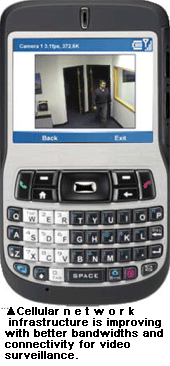With more and more powerful and sophisticated wireless networks and handsets, people can now enjoy a myriad of applications while on the go. Surveillance software on mobile devices is one of the growing applications.
With more and more powerful and sophisticated wireless networks and handsets, people can now enjoy a myriad of applications while on the go. Surveillance software on mobile devices is one of the growing applications.
Today, there are about two billion cellular phones worldwide and about 180 million cellular phone users in the United States, and both figures are expected to grow. In Asia, there are 12 million cellular subscribers in Malaysia alone; 600,000 of them are using 3G phones and approximately 100,000 take advantage of mobile surveillance.
According to In-Stat's 2008 survey on mobile video content choices, high-quality  mobile devices (such as Apple's Wi-Fi iPhone and iPod Touch) are improving wireless access to the Internet. Dr. Olinga Ta'eed, CEO of Pedagog, cited Infonetics Research to point out that the worldwide mobile video service revenue (content streamed to cellular phones) is estimated to rise to approximately US$5.6 billion by 2009.
mobile devices (such as Apple's Wi-Fi iPhone and iPod Touch) are improving wireless access to the Internet. Dr. Olinga Ta'eed, CEO of Pedagog, cited Infonetics Research to point out that the worldwide mobile video service revenue (content streamed to cellular phones) is estimated to rise to approximately US$5.6 billion by 2009.
The market for rich data over cellular networks is also being driven by telecommunication operators, as "they seek to find other data communication offerings to increase revenues," added Ta'eed. The notion was seconded by Jack Yip, Sales and Marketing Director for I-Pocket Solution: "The market for 3G Internet services is booming. Service providers cannot sell 3G alone, so they have to capitalize on many application packages such as movies, ring tones and games."
Ability to watch live video wirelessly spurs many opportunities. One Internet  service provider (ISP) in Southeast Asia concluded in their research that surveillance would be one top application. Surveillance software on mobile devices allows people to access their camera images via their mobile devices, such as phones and laptop computers. Users can remotely adjust basic controls of their DVRs and cameras, such as search, playback, and full pan, tilt and zoom.
service provider (ISP) in Southeast Asia concluded in their research that surveillance would be one top application. Surveillance software on mobile devices allows people to access their camera images via their mobile devices, such as phones and laptop computers. Users can remotely adjust basic controls of their DVRs and cameras, such as search, playback, and full pan, tilt and zoom.
Closed Architecture
Some software can only be sold when packaged with the developer's own hardware. "We sell our portable cameras, bundled with our own surveillance software," said David Gilbertson, Managing Director of Wireless CCTV.
The camera system has an integrated camera and transmission unit. It contains 3G mobile technology and operates on cellular networks. Users are able to dial in remotely to access both live and stored footage on the internal hard drive. "Each system also has an IP address, allowing it to utilize broadband technology that offers high-speed, fixed-cost transmission for live monitoring," said Gilbertson. "This is ideal for situations where there is access to a telephone line with broadband connection."
Pedagog offers wireless cameras bundled with its own surveillance software. "Our camera has a SIM card inside (just like a cellular phone). The card makes a connection to our middleware, and from the SIM card, video data is compressed, transmitted live to the middleware and then sent to our handheld device," explained Taˇeed.
Price and ease of use are definitely top concerns. Plug-and-play should be the  minimum requirement; no other configurations are needed. "Users will either go to our Web portal or dial into the call center representing us, and download a player (the surveillance software) to their cellular phone," said Ta'eed. "The file is small (about 60 Kb) and takes only 20 seconds to download. Users can then dial into their camera from anywhere in the world to watch live footage over standard GPRS." The middleware architecture allows Pedagog to lower the camera cost and make profits from actual usage.
minimum requirement; no other configurations are needed. "Users will either go to our Web portal or dial into the call center representing us, and download a player (the surveillance software) to their cellular phone," said Ta'eed. "The file is small (about 60 Kb) and takes only 20 seconds to download. Users can then dial into their camera from anywhere in the world to watch live footage over standard GPRS." The middleware architecture allows Pedagog to lower the camera cost and make profits from actual usage.
"The middleware encrypts video, stopping unauthorized people from accessing it," Ta'eed explained further. "Each camera is hardware-encoded with IMEI and the IMSI numbers (serial numbers on the SIM card for the camera and modem) so no one can steal images from the SIM card." The middleware also stamps every image with time and date, and indicates which camera the image came from and who retrieved the image.
"This gives traceability to all image s so they a re good for evidential purposes. Web cameras are easy targets for hackers, and that is why every image from our camera needs to be tagged to ensure its authenticity," added Taˇeed.
Arteco Vision Systems' Java-based software complements its intelligent video surveillance (IVS) server. When the server detects an event and triggers an alert, the software works in tandem with remote notification. Security operators can access live video immediately, assess the situation and take proper counter-measures.
"IVS-associated false alarms represent a serious issue facing the security industry," said Steve Birkmeier, Vice President of Arteco Vision Systems. "The software helps reduce such alarms through video verification, further extending video analytics as a force multiplier."
Open Architecture
Software with an open architecture can be connected to any types of network cameras, video servers and DVRs. "Depending on the functionality and complexity of the product, as long as SDKs (software development kits) and OCXs (object linking and embedding control extensions) are provided, we can support all hardware features," said Yip.
Required technology also includes a video service provider. "You need to 'rent' a  cellular phone video service that provides connections from your home or business," said Sri Palasamudram, CEO of mobiDEOS. "It costs about $10 to $30 per month, depending on the number of cameras and features, and video signals can be adjusted to fit your handset."
cellular phone video service that provides connections from your home or business," said Sri Palasamudram, CEO of mobiDEOS. "It costs about $10 to $30 per month, depending on the number of cameras and features, and video signals can be adjusted to fit your handset."
"The advantage of an open architecture is that customers can use the current investment on both hardware and software and extend it for mobile viewing," said Palasamudram. "In the closed architecture, customers have to abandon existing investment and make new purchase. Closed architecture also locks customers into a particular system."
While an open architecture allows end users to have more options when choosing front-end devices, limitations lie in network cameras that use nonstandard compression formats. "Most network cameras now use H.264 and M-JPEG so there shouldn't be any integration problems," said Yip. "But if other proprietary compression formats are adopted, it may pose challenges for software integration. Camera manufacturers, as a result, must provide developers more detailed information on communication protocols."
Another challenge is cost. "A significant portion of the overall cost is associated with surveillance hardware," said Taˇeed. "Open systems require special engineering on surveillance cameras and DVRs. Consumers would find this too costly or time-consuming." Broadband connections can also be expensive. "While broadband is available in many countries, consumers are not necessarily interested in paying more on top of regular Internet charges."
Compatibility Issues
The sheer number and variety of network cameras and cellular handsets available on the market are making compatibility No. 1 issue for all, suggested both Yip and Palasamudram. Most of the current phones adopt either one of the four platforms: Blackberry, Java, Symbian or Microsoft. Java phones include Sony Ericsson and Motorola; Symbian-based devices include Nokia; Microsoft-based ones include smart phones such as HTC.
A key challenge is that whenever there is a new model, software developers have to make sure the software is updated with the correct version of operating system (OS). "Even if I have the software compatible with six different models now, six months down the road there are 24 new phones. The software may not work with these models as they are probably based on different versions of Symbian or Microsoft," explained Yip. "When users cannot connect to the system, they would think your product is faulty not the fact that there are different OS versions." So for software developers, their ability to keep up with newer OS versions is key for success.
Often, software testing is done via a simulator as it is simply not feasible to physically test each and every handset. Even if everything works out well during simulation, it does not guarantee that real-life performance would be the same, cautioned Yip.
While some point out that newer phones come with faster processing chips to compress and decompress video images more quickly and to provide better experience, Ta'eed holds a different view. "One restriction you often find on surveillance software is that it can only be used on select high-end phones, such as iPhones and Blackberries."
Some software providers are counting on handsets to do all the intelligent work, so only high-end phones are compatible to do video viewing/decoding and camera controls, Ta'eed said. 'Since we put all the intelligence in the middleware server, entry-level cameras and phones can also work with our system," said Ta'eed.
Mobile Communication Standards
Mobile devices have innate limitations, due to screen sizes and processing speeds. Only basic functions can be performed: switching on or off, viewing, playback, checking alarms, and panning, tilting and zooming for cameras. "If you want more advanced functions or simultaneous playback from multiple channels, itˇs not possible," said Taˇeed. "It may be feasible to go up to four channels, with a PDA phone and fast wireless connections like Wi-Fi."
Cellular network infrastructure is improving with better bandwidths and connectivity for video surveillance. The most commonly seen mobile communication standard is GPRS, which on average transfers one image every two to five seconds. 3G, on the other hand, transfers one to four, eight (HSDPA) or 12 (HSUPA) frames per second. "At your home or business, you need to have an outbound bandwidth of at least 512 kilobits per second to view video at five frames per second with a resolution of 320 by 240," said Palasamudram.
"Software developers must continue to improve functionality and know how mobile technology will evolve next," added Gilbertson.
Business Model
Mobile surveillance software developers normally work with telecommunication companies or ISPs, who promote their software to cellular subscribers as an optional package and charge monthly fees. "Developers work with camera makers to provide OEM models to telecoms to profit share from subscriptions," explained Yip. "Or they can have their own servers and appoint dealers to market their products."
Other developers take advantage of air time. "Every video clip or phone call goes through our middleware server, and we measure how much is used by the end user to get a fraction of the air time," said Ta'eed. Pedagog also gets a fraction of the service charge from its partners on automatic text messages that are sent when PIR cameras are triggered. "Itˇs about a lot of incremental charges with small value," said Taˇeed.